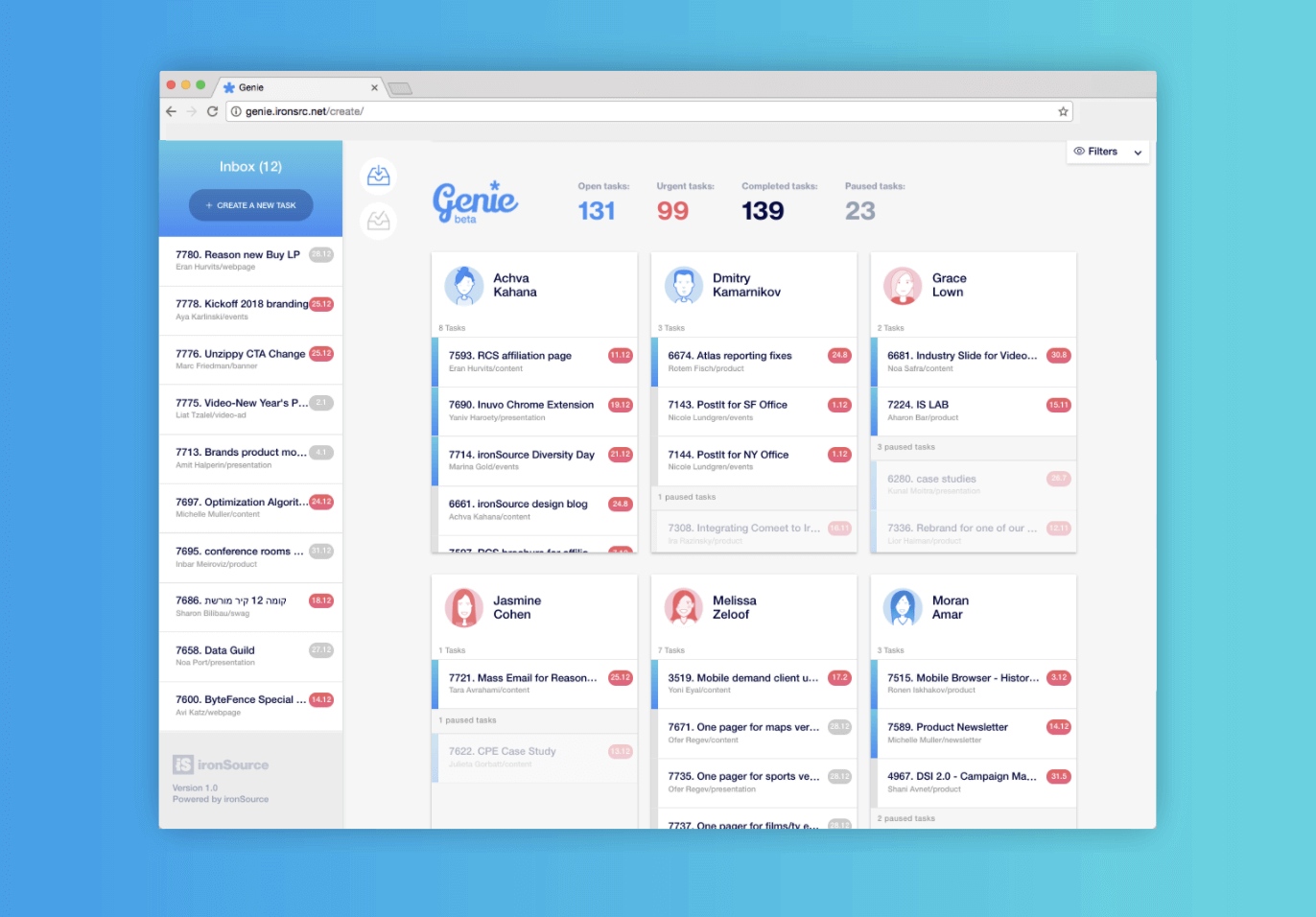Achva Kahana is the Studio Manager at ironSource.
I manage an in-house design Studio, which means other employees in the company - from human resources to salespeople - are like our clients. Last year, when our company merged and doubled in size, so did our client pool. Overnight, my team of 8 was responsible for more than 700 “clients” spread across 5 global offices.
When the company was smaller, I knew everyone in the company by name and face. If an employee needed something designed, like a sales deck or a t-shirt, they’d come to my desk or shoot me an email. I’d shout across the room and ask someone on my team to take over the project.
Needless to say, this process didn’t work so well after the the company started expanding. We looked at Jira, Asana, and Trello, and other task management systems to help us sort out the influx of design projects we were getting. But no platform quite fit. Unlike product managers, for example, which we learned most management systems are intended for, designers don’t usually work in a pipeline. In other words, projects don’t move from one designer to another. Instead, a single designer is responsible for the entire project, from A to Z.
After failing to find a task management platform that worked for us, we decided to build our own. And that’s how Genie was born.
Function follows design
Usually, there’s a long, complex process to producing a new product like this. But we didn’t have the time. We needed a platform, and we needed it fast. The best approach, we decided, would be to start with a quick proof of concept (POC) and then add features overtime.
It was easiest this way - after all, we’re designers above all else. We look at everything with a designer’s eye, so it was only natural for us to first create a basic POC that looks and feels beautiful before finalizing a vision for a completed product.
This “design first” approach enables us to be more creative, since we can design and build products in increments, gradually over time, rather than in one fell swoop. It leaves room for flexibility - which if you’ve ever built a new product from scratch, you know is very important.
Genie started out as a simple form. It worked like this: the client (aka the company employee who needed something designed) would fill out the form with all the necessary information - what is the task, who is it for, when do you need it by. I’d receive the request, then assign it to one of the designers on my team.
At its core, Genie more or less still works like this today. But the form is more complex now. Employees can choose from a range of different projects, from swag to platform UX. They can request a designer they’ve already worked with. They can attach assets. They can edit the form after they’ve submitted it. They can ping us and ask where the project stands. They can receive progress notifications in their email, and see a progress bar on the platform. They can CC their colleagues.

Each of these features were added after we created and launched the initial product. In fact, we’re still adding new features all the time. This is what I mean when I say “design first.” It’s not that functionality isn’t equally important to us. It’s just more comfortable for us to start off with what we’re great at, and add features as we go.
On the Studio side, now we can drag and drop tasks into each other’s folders, passing projects along from designer to content writer. We can ping the person who opened the task and ask them for more information. We can put a task on hold if we’re waiting on someone else for assets. We can mark tasks when we’ve started working on them.
What it looks like
It was also super important for us was to keep our friendly vibe and communicate that neighborly feeling to the company employees. In addition to building a user-friendly and intuitive interface, the bulk of this mission was rooted in subtle design and copywriting.
Even the name Genie is whimsical and playful. It tooks us a while to land on it, but we liked Genie because it sounded exactly like what it did: a platform that grants your every wish.
We created cute avatars for each designer on the team, so that once a task is assigned, the employee sees a friendly face on their dashboard. This way, even though we can’t meet with everyone personally, employees can still put a face to the name in their inbox.

The copywriting also completely reflects the Studio’s personality - funny and maybe a bit weird, but eager to help and always ready to give it our all. The form is super casual and speaks to employees like I’d speak to them at my desk. Once a task is complete, and the designer marks it as “done” on their end, the employee gets an email that reads: “Booya! Your wish is fulfilled!”
Wrapping up
Genie was a massive success, and is used by nearly all of ironSource’s 700 employees in offices worldwide. Next, we’ll work on an analytics solution to see how and where we can improve Genie’s features. Stay tuned.




